Afifa Aleiby on Iraq,
her love for all Arts, her time in Russia, Italy and Yemen,
on Art reflecting War, on Art and Politics,
Highlighting the Female Figure and
Art Bringing People Together
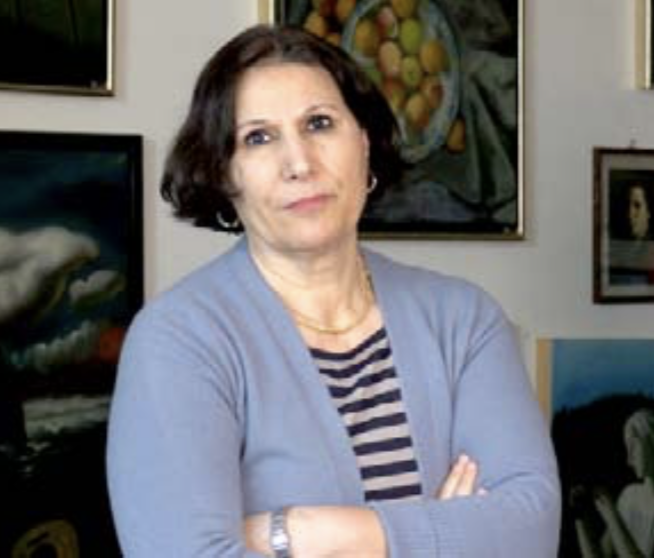
Afifa Aleiby
In this interview with Afifa Aleiby, the artist discloses her thoughts in relation to questions we were curious to ask her, such as, what first drew her to art, and how Iraq and her childhood there impacted her work. We also wanted to find out about the art scene in Iraq and on her time at the Institute of Fine Arts in Baghdad, whether or not there were any barriers to confront and any censorship during her time as an illustrator for the Iraqi press.
Afifa Aleiby studied at the Suikuv Institute in Moscow, and then found herself living in Yemen and Italy, settling in the Netherlands. We were enticed to find out if and how she continued to combine her art with political elements.
Having developed a particular art style, from monumental art, to a Renaissance type alongside a social realism style, the female figure features prominently in Afifa Aleiby's art. They are poetic and alluring, as well as sculptural in form, what the artist is trying to convey through these figures interested us to find out from the artist.
Art can be both a personal tool or a collective one. Having lived in several countries, Afifa Aleiby encountered different cultures, which are found through and into her art, she merged collective histories and her personal one, cultural identities and political references, so enquiring whether she felt art can sometimes speak louder than politics, and may unite communities, felt like a natural question to pose the artist.
2020 has been a challenging year for many, as the world faces COVID-19, it has affected us all. Has art helped the artist during these times and what are her hopes for the future?
All these queries and contemplations we asked Afifa Aleiby and below are her thoughts, taking us on her touching journey of art, emotion, pain, love and discoveries alongside her powerful, beautiful, moving and poetic art...
(Scroll all the way down for Arabic version)
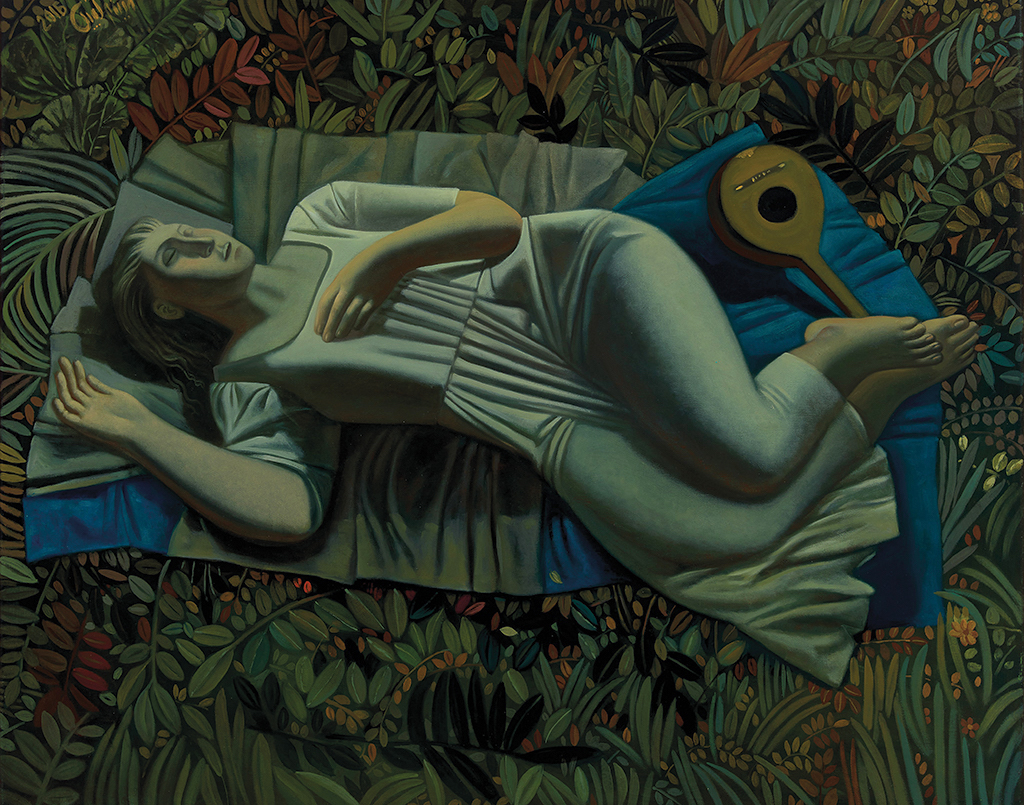
Moonlight. 2016
I am the youngest of my family, and noticed throughout my childhood, that most of my brothers were interested in the arts, be it, music, fine art, sculpture, poetry, literature, cinema or theatre.
We had a large library at home with a variety of books, including foreign literature translated into Arabic and art books on many international artists.
I loved observing my brothers interests in art, and thus I also began practicing drawing, reading books on art, and especially diving into world literature which fascinated and enchanted me. Books provided me with much scope for my imagination and opened me up to different perspectives. All my summer holidays were spent reading.
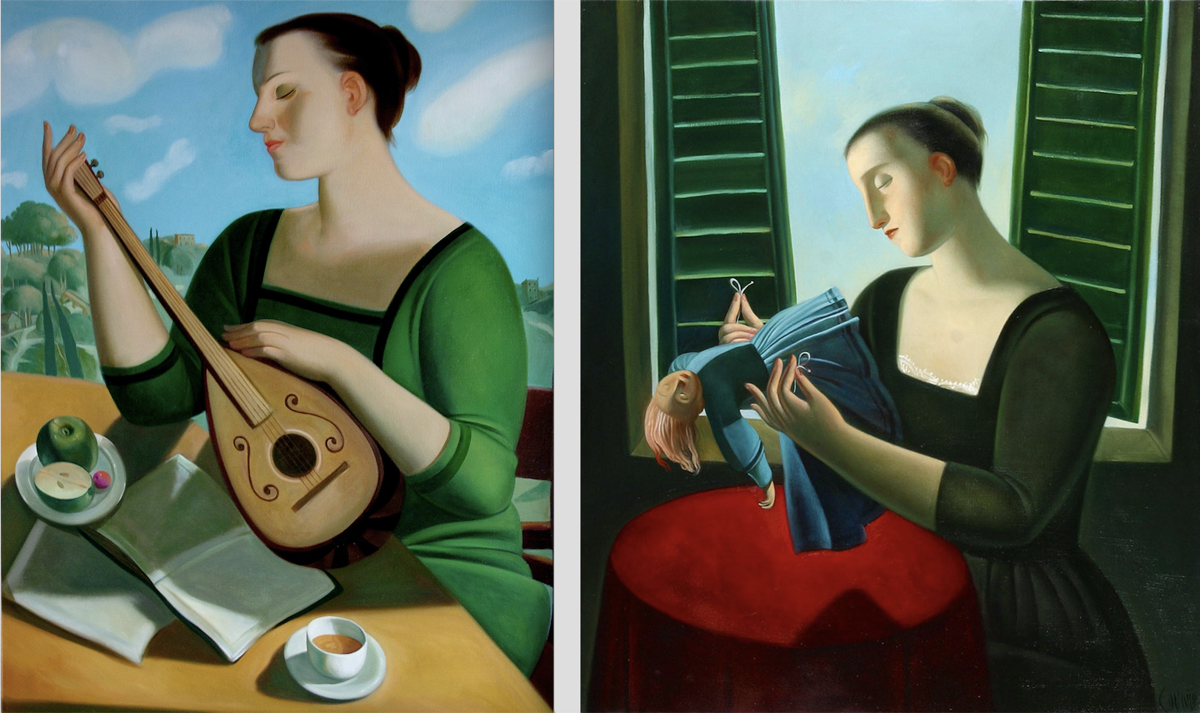
Mandolin and Making Dolls
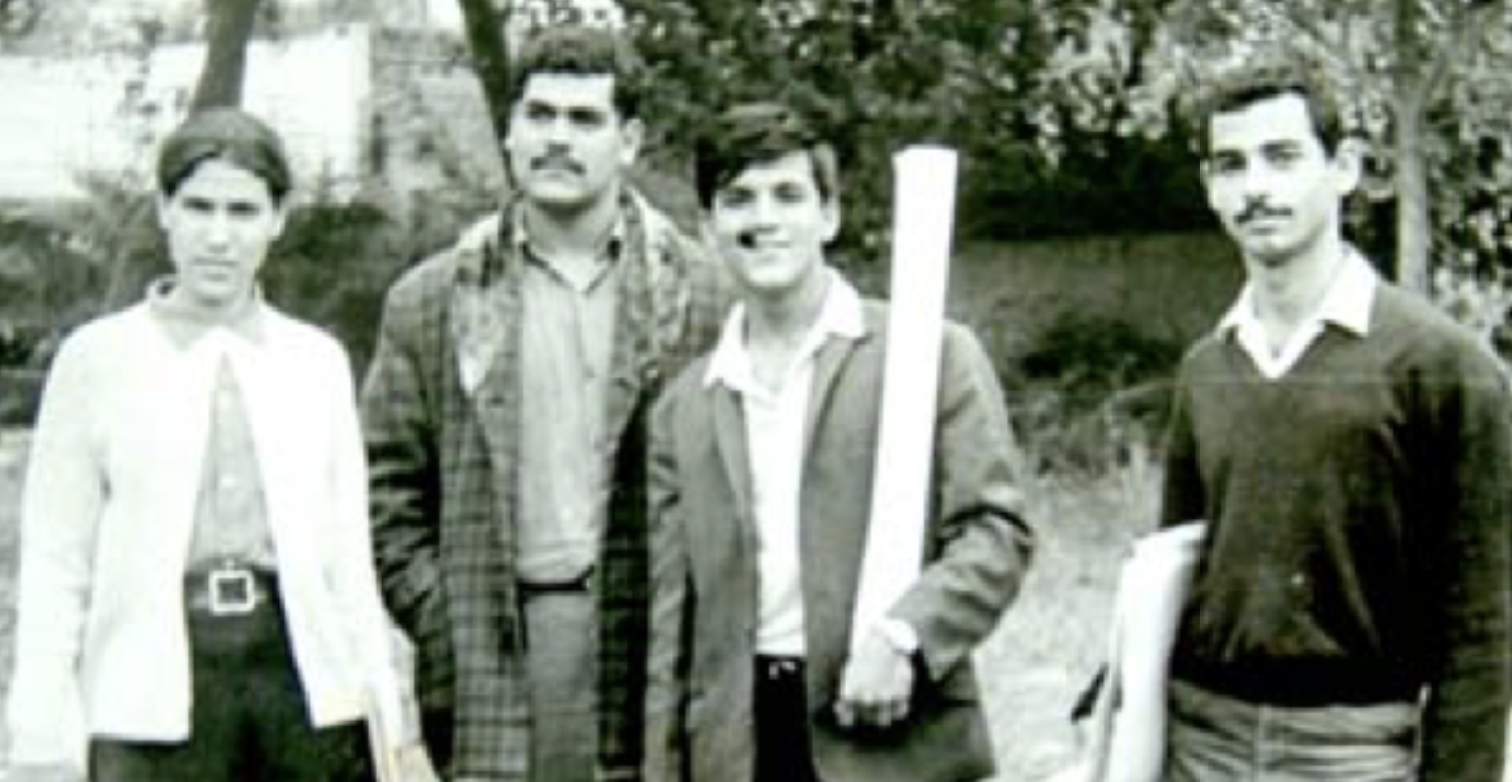
I participated in artistic competitions that were held annually in Iraqi schools. From a young age, my teachers took interest in my art skills, as they realised how much I loved to draw and to study art. At home, I also received many encouragements from all my family members, specifically from my mother and father.
Once I completed my intermediate studies, I decided to become a painter and dreamed of going to Baghdad to study art at the Institute of Fine Arts like my brother Faisal, who had completed his studies there and continued by enrolling at the Academy of Fine Arts in Baghdad.
My family did not oppose or refuse my wishes to do so, on the contrary, things were arranged so that my mother could move with me to Baghdad, leaving our home affairs in Basra under the supervision of my sister Leila. Indeed, my mother’s presence with me and my brother in Baghdad, had irreplaceable value, it helped us a lot, most importantly, we did not feel alienated or have the sense of missing family.
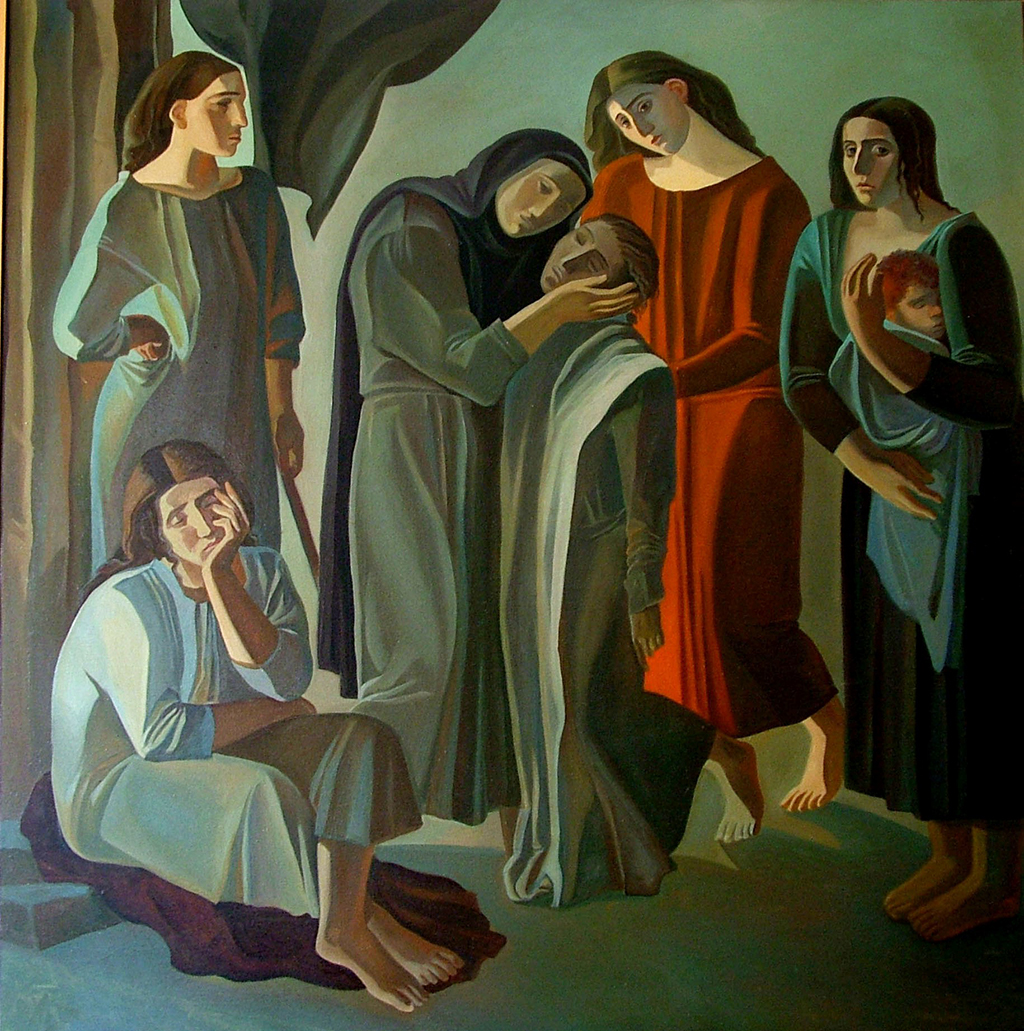
Mother. 1984. Oil-on-canvas 120-x-120-cm
The five years I studied at the Institute of Fine Arts in Baghdad were filled with much happiness.
I was taught by Iraqi professors, such as Rasool Alwan, Muhammad Ali Shaker, Muhammad Shaker Al Saeed, Miran Al Saadi, Sadiq Rabih, Rafeeh Al-Nasiri, Muhammad Mehr Al-Din, Muhammad Aref, Mahud Ahmed and many others, most of whom were graduates of European institutes, prominent artists in their own right and excelled in their work.
Throughout my studies in Baghdad, I participated in almost all art exhibitions that were held regularly along the corridors of the art Institute, as well as part of the Association of Iraqi Artists and in the Museum of Modern Iraqi Art (Culpkenian Museum), which had then, acquired two of my works.
The relative political and economical stability in Baghdad at the beginning of the seventies, had a great impact on the lives of Iraqis, in particular young people. That stability enabled an opening towards culture and the arts. People’s interest in affairs increased, important publications and printing flourished, with all segments of society taken into consideration. Books, magazines and newspapers specialising in children's affairs, youth and women were accessible. There was an emergence of left-wing publications which spread widely and publicly all over Iraq, as well as across all media.
This great cultural openness had a valuable effect on life in general and personally on the development of my artistic production. Especially, during the time I worked as a painter for one of the most important and progressive left-wing Iraqi newspapers Tareek Al Shaab newspaper and the New Culture Magazine, read at that time, by all segments of Iraqi society, but in particular the elite and the left-wing Iraqi intellectuals. My layouts had a distinguished and striking presence in the Iraqi cultural milieu, because I was the first young girl to undertake journalistic work as an artist.
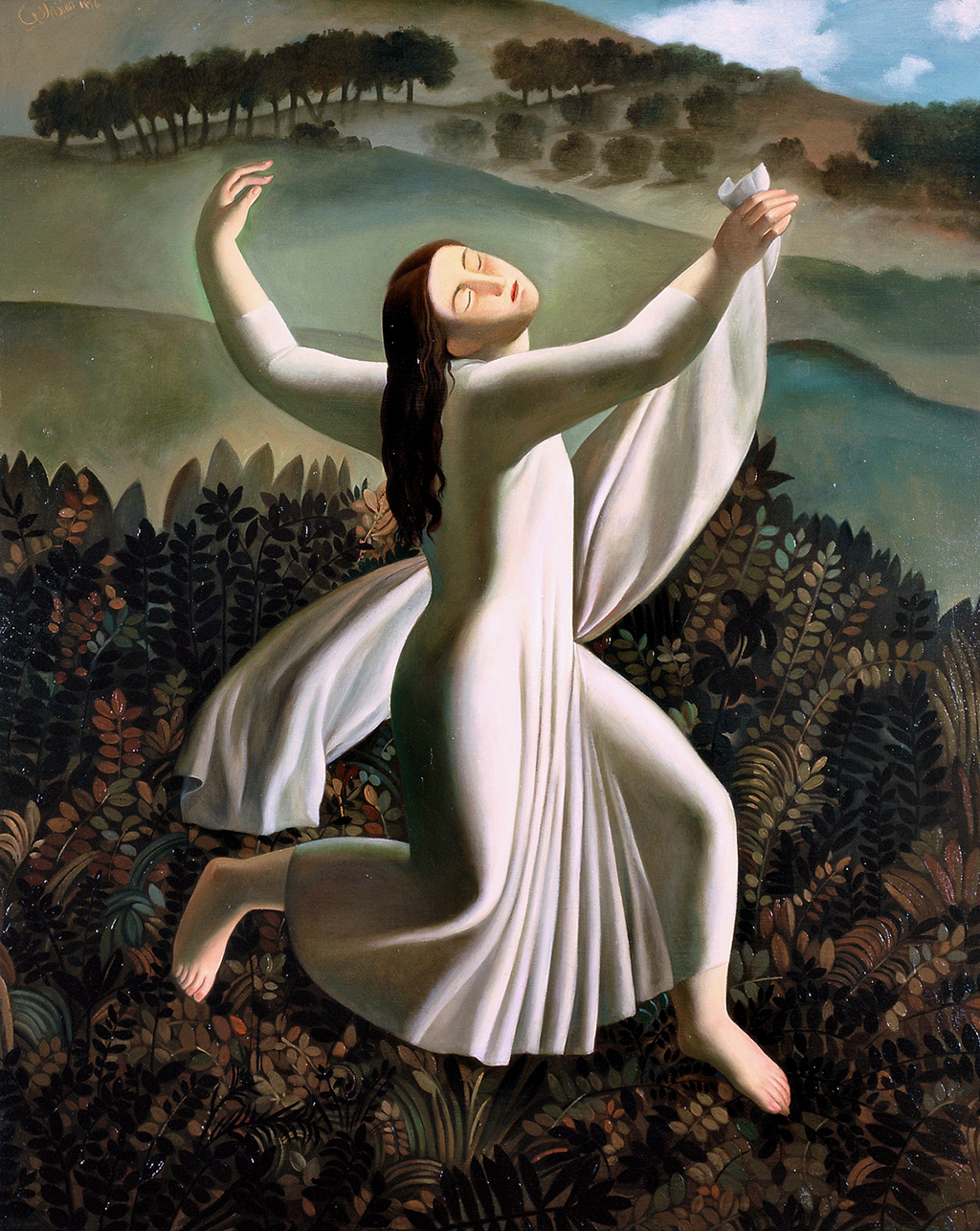
Enchantment. 2001. Oil-on-canvas. 100-x-80-cm
I carried on reading books from the library of my brother Faisal in Baghdad, and also followed up with everything that was published internationally on the arts. I liked the work of many European artists, their various working methods fascinated me. I loved impressionism, and the works of contemporary artists. They did not submit to the rules of art that came before them. I very much admired the work of Degas and of Toulouse Lautrec. At the same time, I enjoyed works from French academic artists, such as David, and the aesthetic styles of Ingres and Delacroix, as well as Italian artists such as Botticelli. In addition, I was very keen on the work of a group of Russian artists, such as Rabin, Vrubel a professor of the symbolic school in Russia, and the magical artist Vodkin from the period of Soviet art.
Reflecting back on why I admired these artists, a diverse group who lived at different times and come from different schools of art, what fascinated me in their works, was their uniqueness.
.jpg)
Dreaming. 1985. Oil-on-canvas. 100-x-70-cm
Whilst, my brother Abdelelah Al-Nossair, left Iraq to study at the Academy of Fine Arts in Rome, and my other brother Faisal Laibi left for Paris to study at the Academie des Beaux Arts, I decided to study in Moscow. Fortunately my admission to the National Institute of Fine Arts (The Surikov Art Institute) was accepted.
My dream and ambition was to specialise in mural art and I actually got approval to study in the mural arts department, where I majored under the well-known Russian artist and fabulous humanist Claudia Alexander Von Totefull.
Russian art and my studies at that institute had much influence on my artwork. I became acquainted with the art of Russian icons and learnt the techniques. It is an art form in its own right, there are a series of techniques, high craftsmanship, and scientific studies needed, in order to specialise in becoming an icon painter.
I also learned how to work on wet and dry walls, the method of glass painting and of mosaic art. All of these art forms are individually a world of absolute magic with amazing surprises, especially for a student coming from Baghdad who was pretty much ignorant of all these types of art.
I worked with unrivalled love for art and was enchanted in the realisation of what I thought were almost impossible dreams.
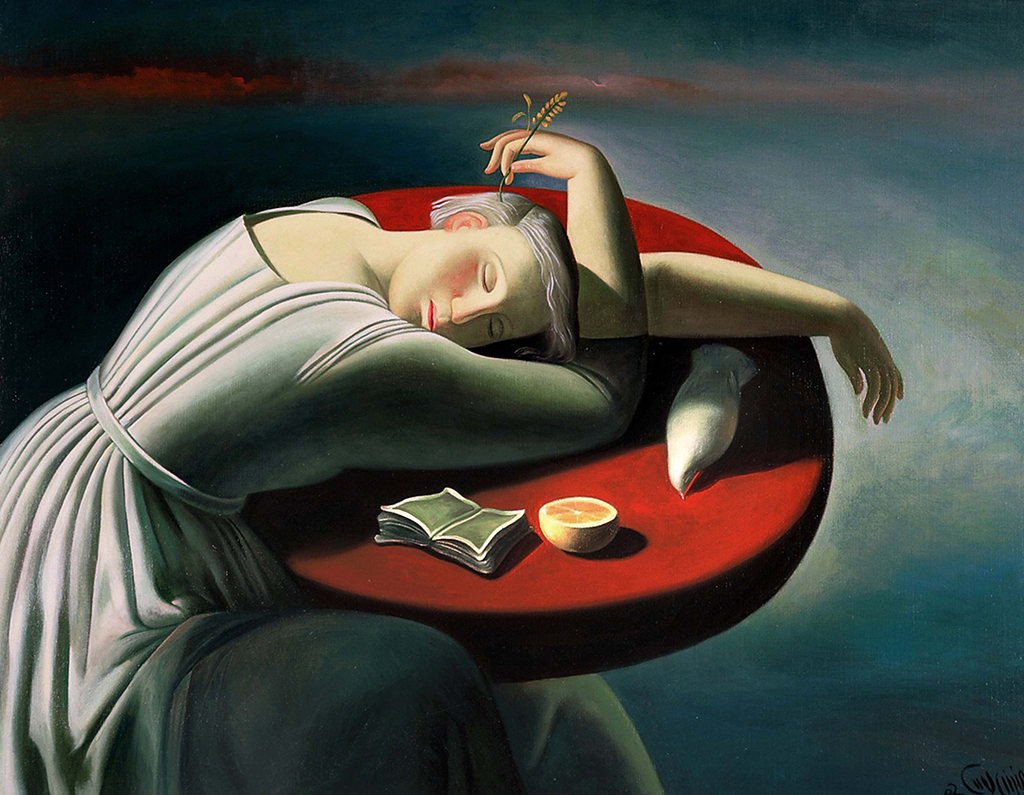
The White Pigeon. 2007.
It was in Moscow when I studied about Italian Renaissance that I became acquainted with humanist aspects. I was able to learn about Giotto, Piero della Francesca, Paolo Uccello, Donatello and Cellini. They are some of the founders of the arts in the Renaissance period with all its branches, engineering and architecture, baring fruit to science and knowledge in all directions. Later, when I was living in Italy I also reminisced on these Italian artists.
My studies in Moscow felt as though I was starting from scratch. I disregarded everything I had previously learnt and began once more to master how to draw the human body, to understand colours and to form a painting. The historical value of the arts, its role in interpreting and writing history through emotions and feelings and the responsibility of an artist were all brought forth.
I became acquainted with great Russian art which was largely unknown to many, due to the Cold War.
I still consider myself lucky to have been able to enter doors that were closed to my Iraqi, Arab, or even European peers. I went through all of that experience with great love, respect and appreciation.
I listened to beautiful music and read Russian literature in its mother tongue. I loved Chekhov, Gorky, Turgenev and Dostoevsky and saw the most beautiful Russian films. I enjoyed walking through Arbat Street, the Gorky Park Gardens, the Lenin Hills and the unique beauty of Izmailovsky Park. I was so charmed by Moscow, its people, its churches, its villages, its rivers and its countryside.
My time in Moscow taught me about all the arts in the world and to distinguish between what feels like pure art versus what is just superficial. I regularly visited museums there, which made me feel like Alice in Wonderland entering a world of discovery, enchanting places seeing famous sculptures and paintings.
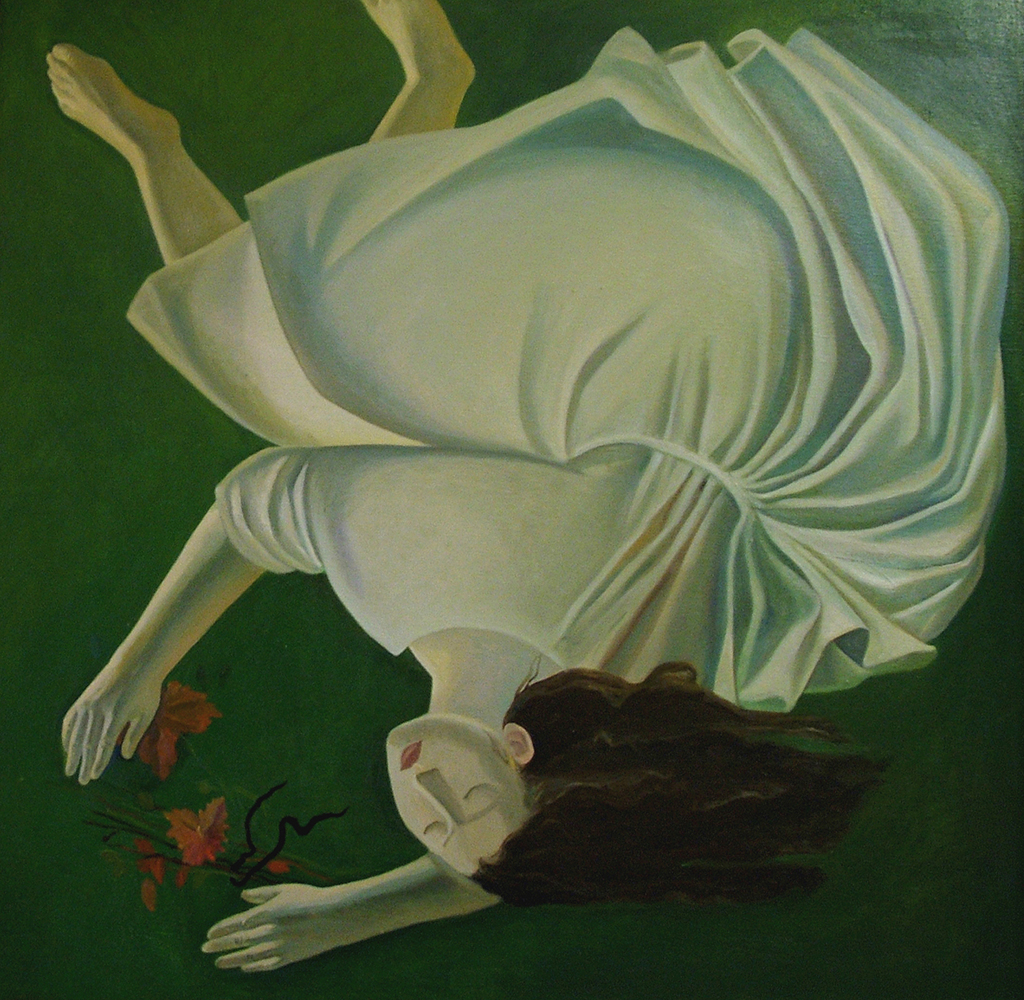
Green-Grass. 1987. Oil-on-canvas. 100-x-100 cm
Politics
Throughout my childhood, my adolescence, and my adult years too, Iraq as a country was in constant sorrow and pain, affecting the lives of Iraqis. The atmosphere in the country was always tense. We were in constant fear, cautious and always looking out for anything unexpected that may occur and harm us at any moment.
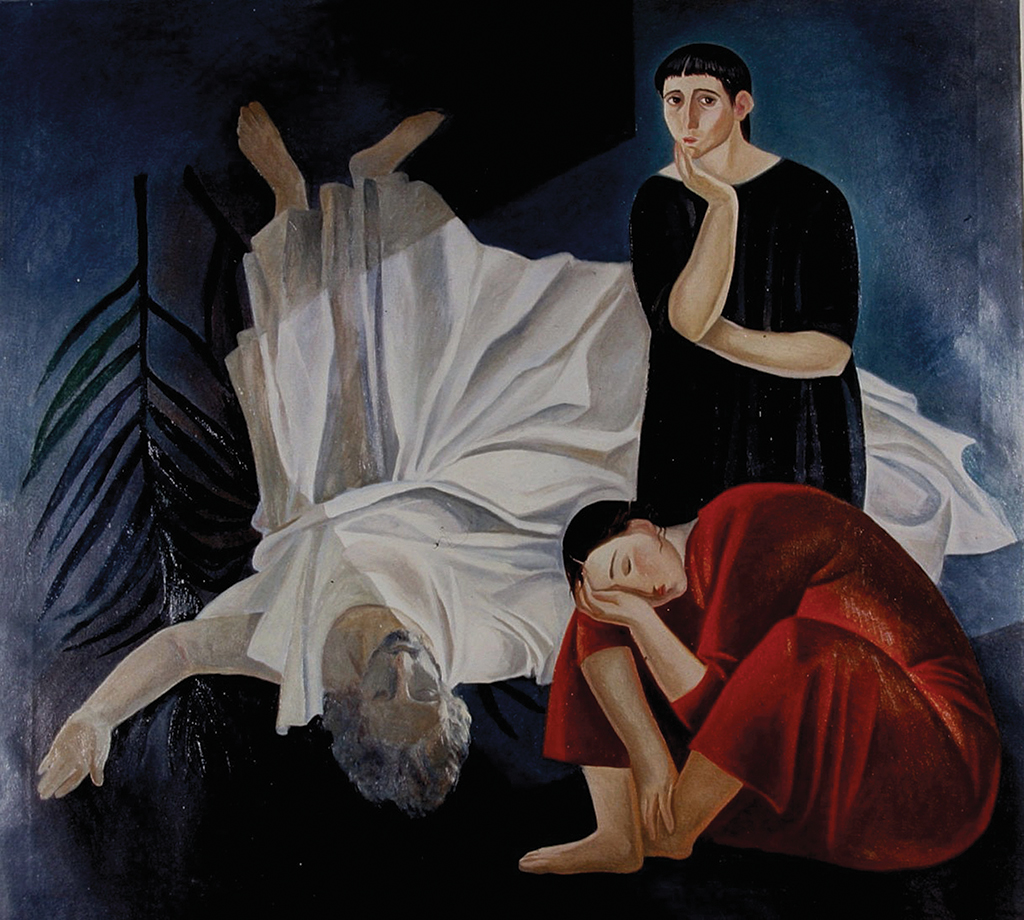
Martyr. 1984. Oil on canvas 100 x 100 cm.
Politics in Iraq has a terrible and influential way of infiltrating all our lives whether we are in or out of the country, we knew what was happening behind the scenes.
For the Iraqi diaspora, an umbilical cord links us to our homeland, just as it once had done to our mothers. This also meant we were not cut off from fearing for our country, or shielded from any pain. It had repercussions for everything we were doing or accomplishing in our daily lives outside the borders of our homeland.
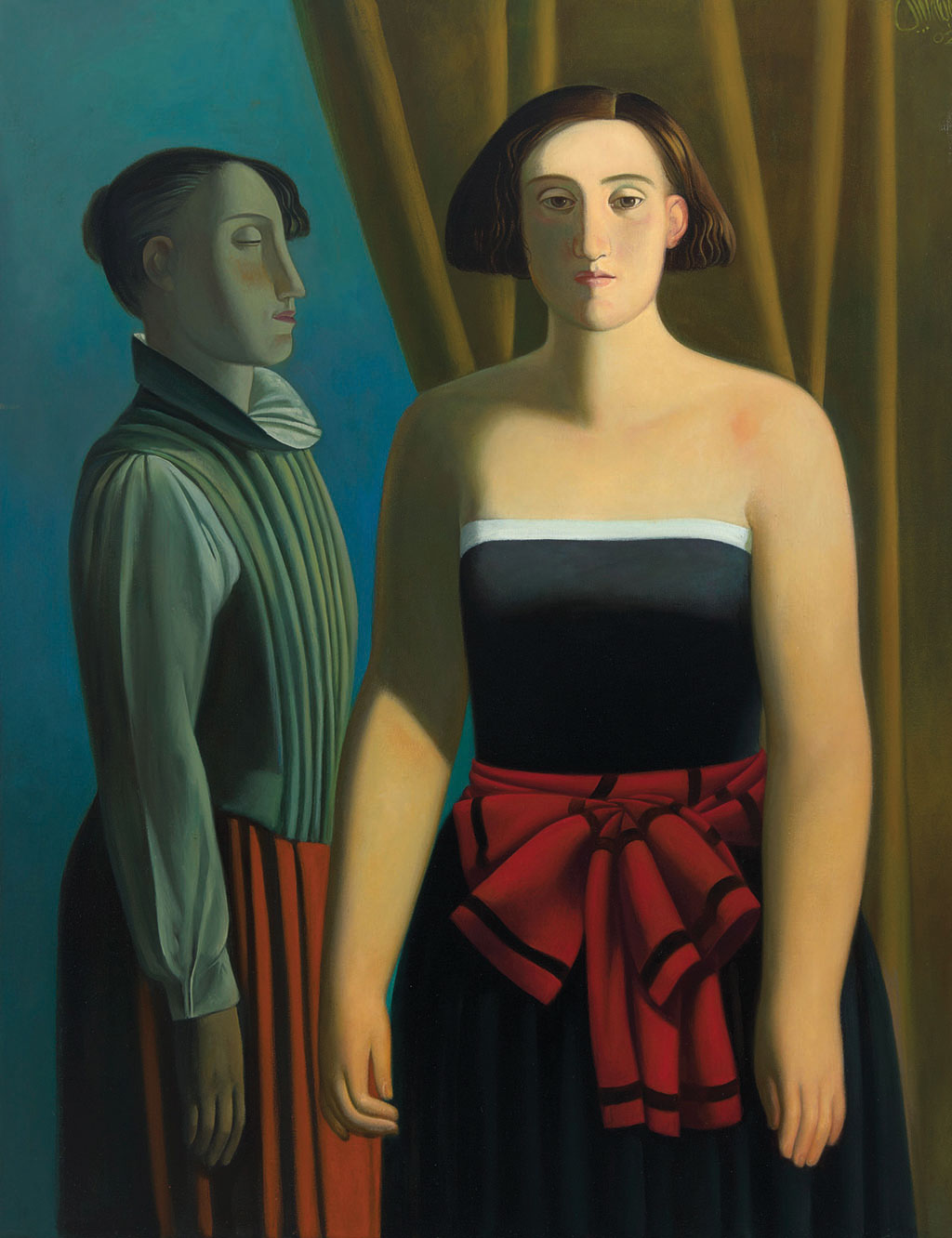
Behind the Curtains. 2012. Oil on canvas. 90 x 70 cm.
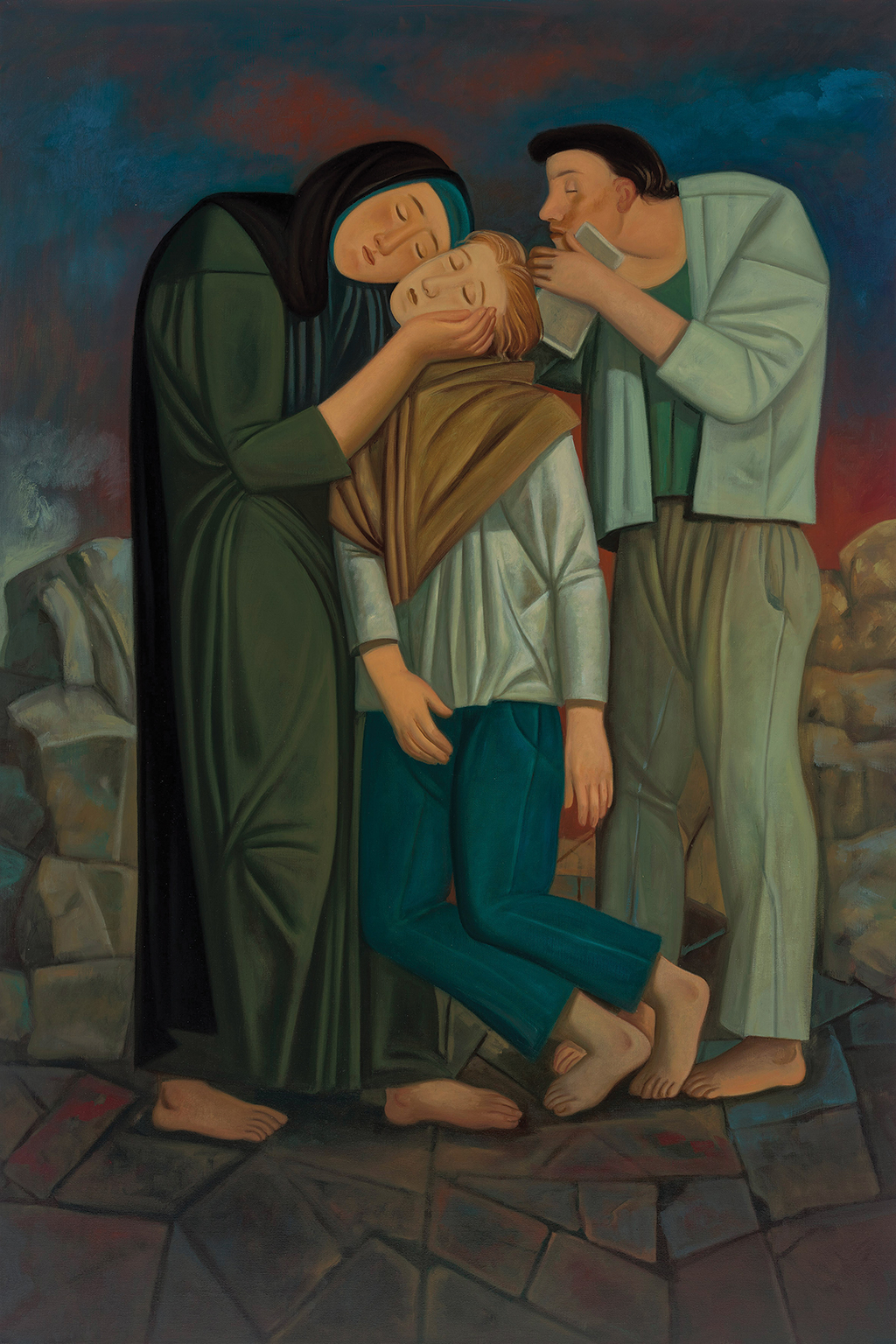
Pain-Oil. 2017. Oil on canvas. 150 x 100 cm.
When I lived outside Iraq, I produced a set of artworks that were of a direct political implication, as a reaction to the suffering of Iraqis and as a stance against everything that was happening in Iraq and to its people from the hands of a dictatorial regime. It was in opposition to what was being done to Iraqis and the nature of the terrorist machine that was crushing the lives of people and destroying all bonds of communication, friendship and love. That changed people and turned Iraq into a land of terror and cruelty.
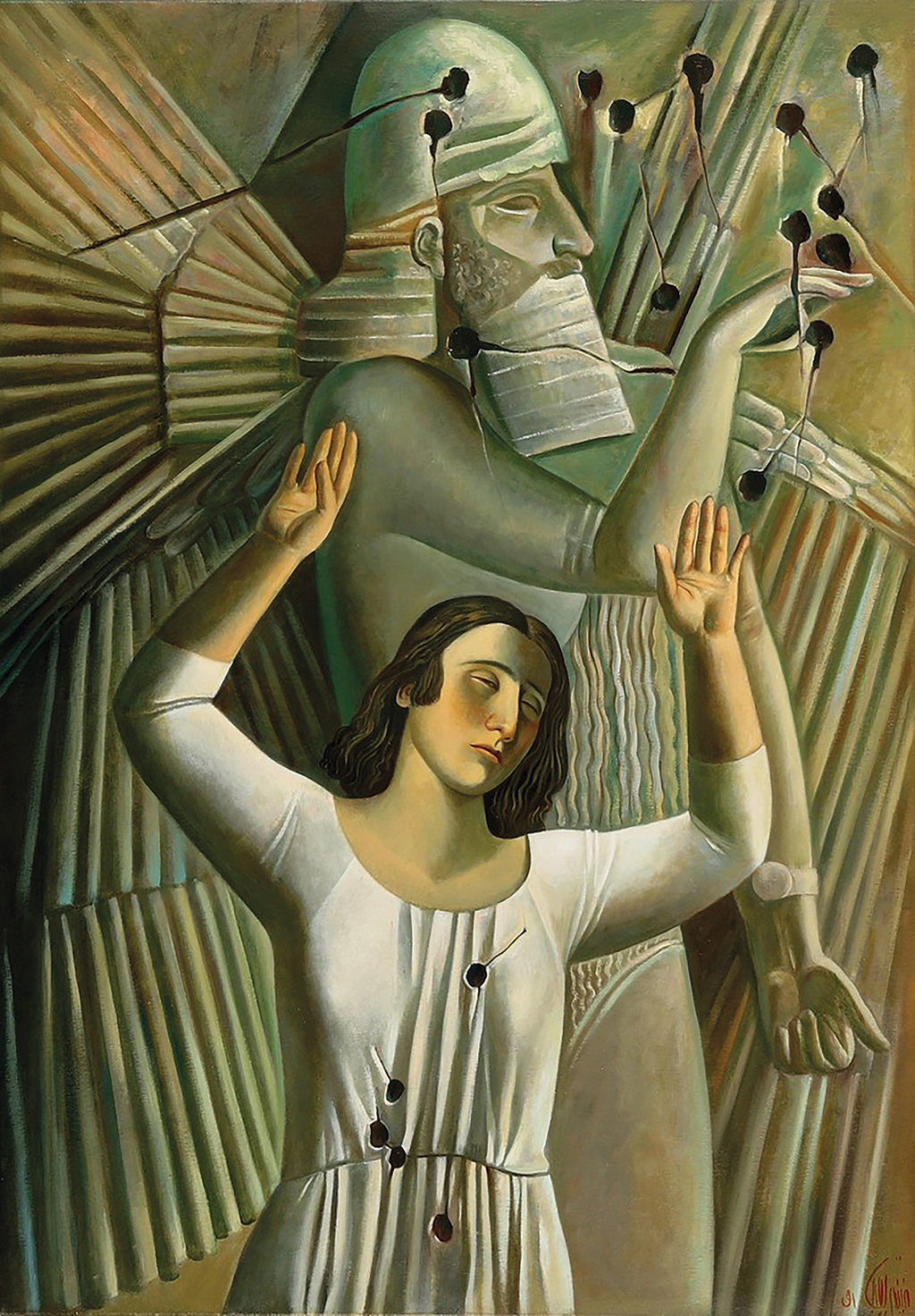
Gulf War. 1991. Oil on canvas 100 x 70 cm.
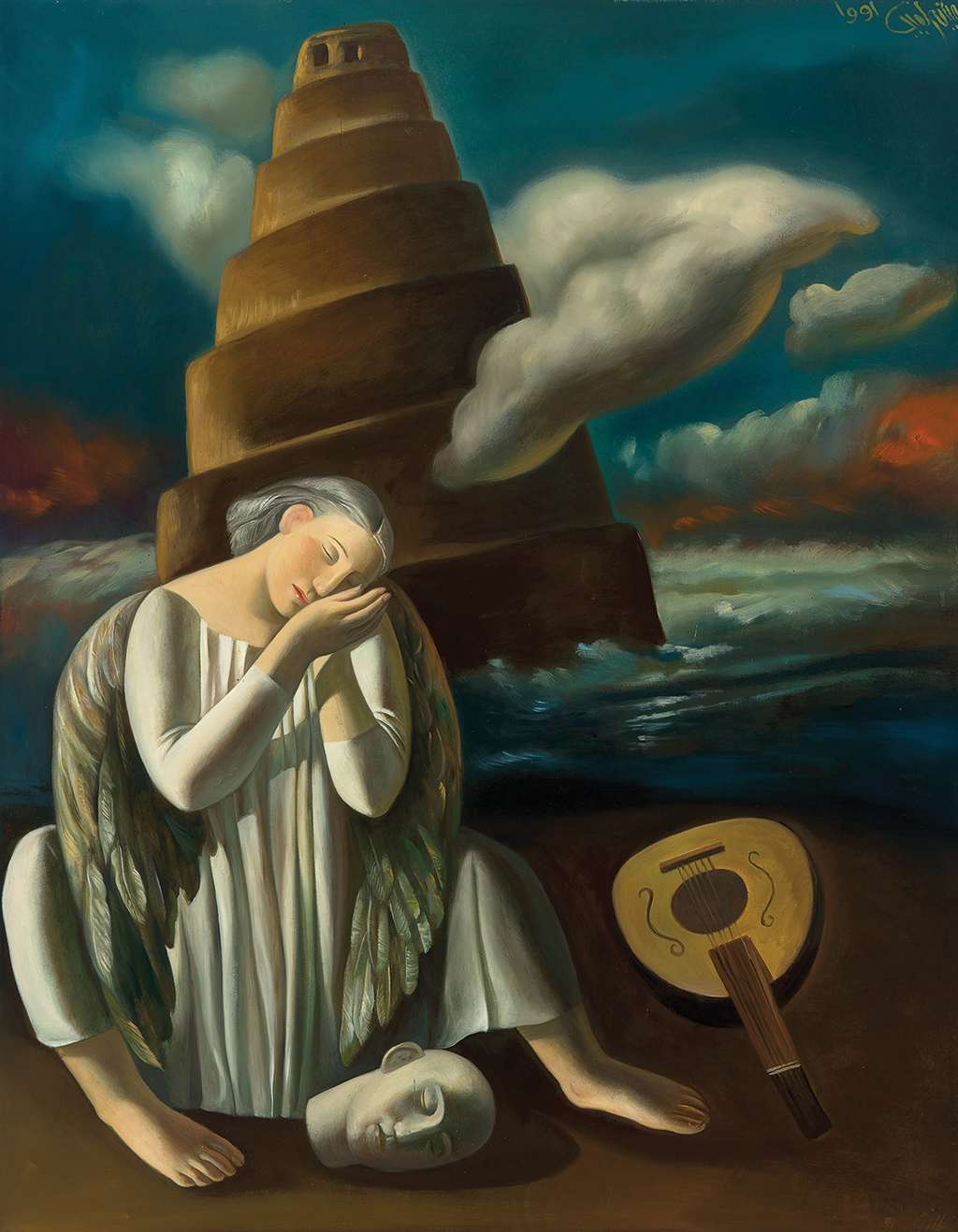
The Flood. 1991. Oil on canvas. 90 x 70 cm
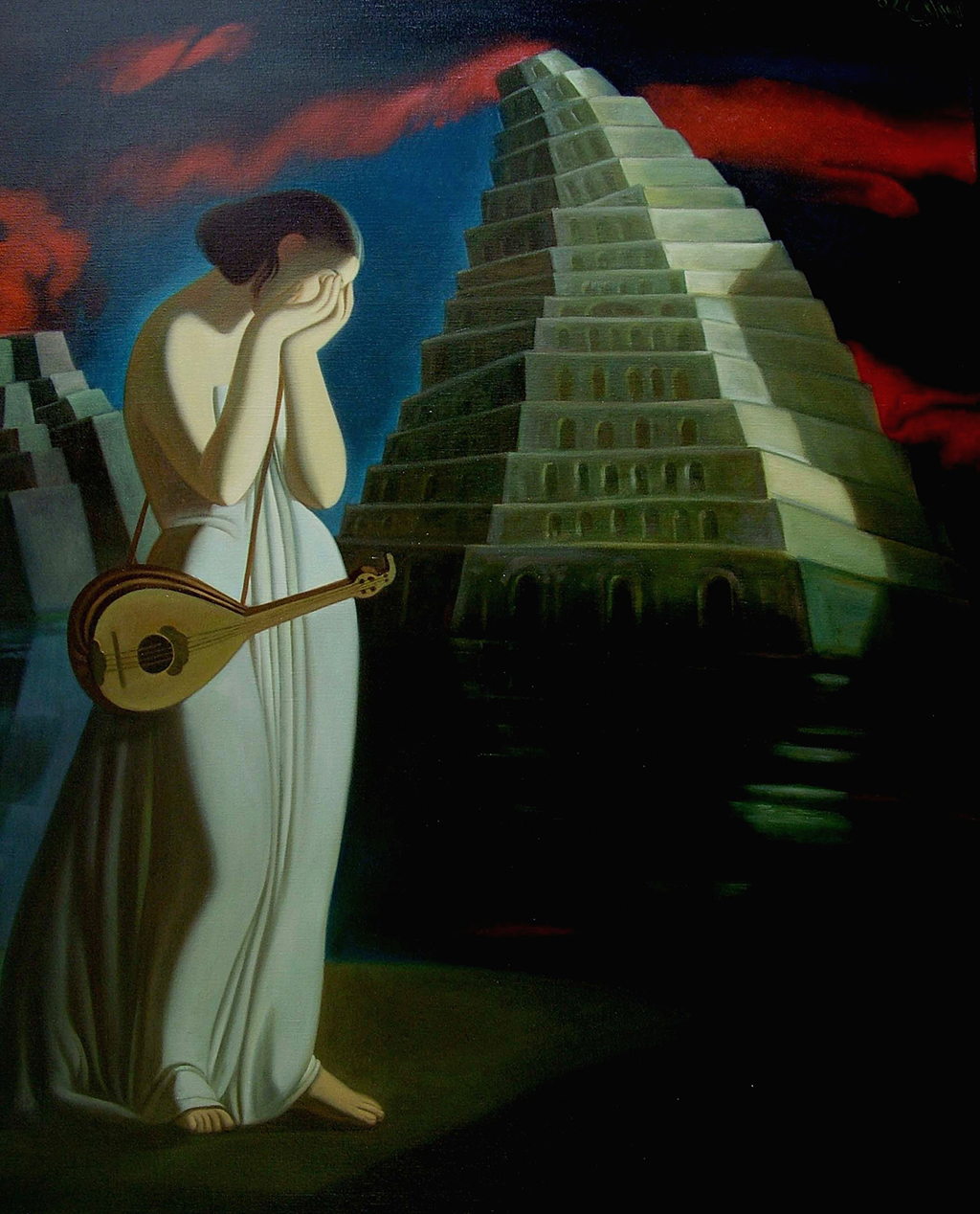
Burning of the Towers of Babylon
My use of the feminist component as a medium to communicate my thoughts and feelings, was effective to create the worlds that I wanted to express through my art. I personally consider women to be the origin of everything, a pillar in life and a positive and beautiful element. Women were the ones behind all the movements of change from the beginning of time to the present day.
The female figure is a fundamental element for my art because it has all the capabilities in helping me relay what I want to say through it. It contains much meaning and multiple facets.
Most of my paintings have a specific meaning or idea behind them, but an idea does not necessarily mean that it is political or of social or educational dimension. There are other notions of artistic dimensions that I’ve researched. Sometimes colour is the concept, wanting to express its value or composition in a painting or it could be regarding light or even beauty and its varied meanings.
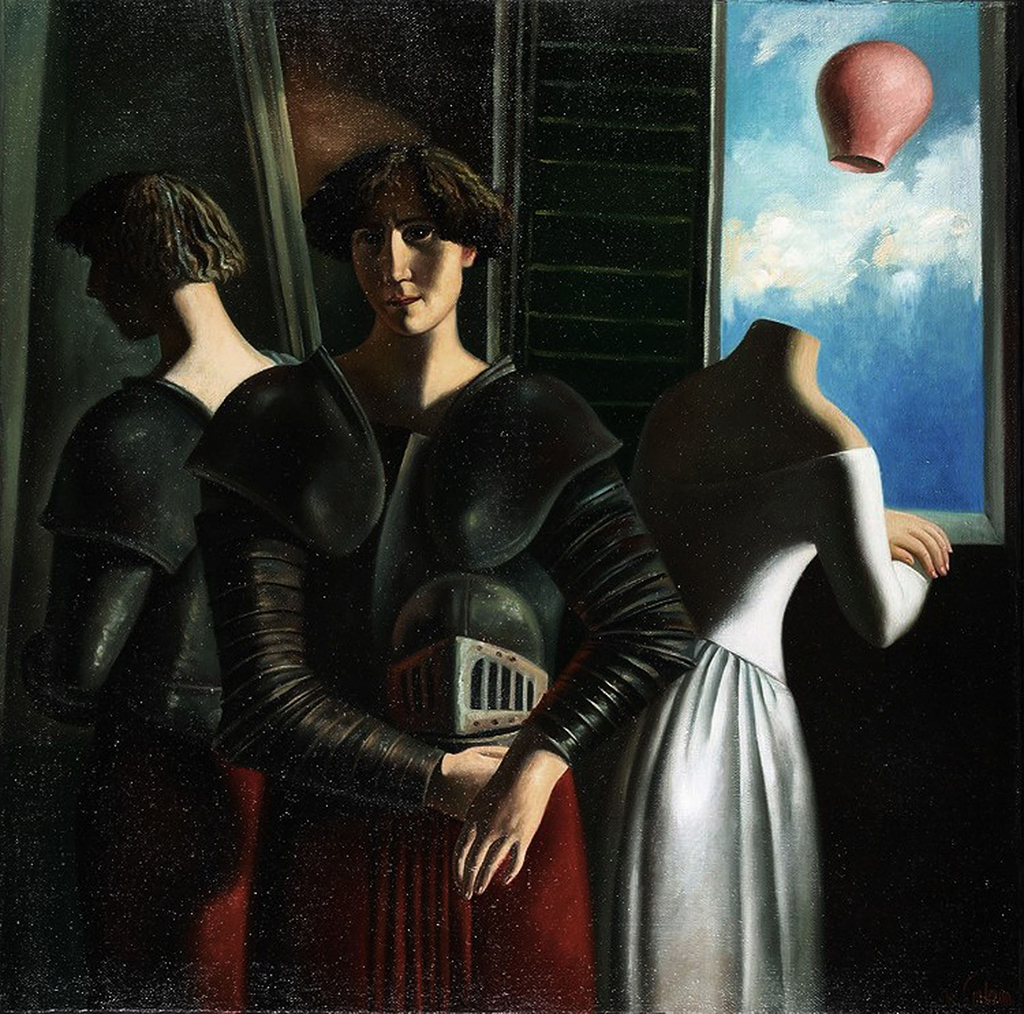
To be a Woman. 1989. Oil on canvas. 100 x 100-2. cm
After completing my studies in Moscow and after my marriage to the Iraqi artist, Jabr Alwan, I went to live in Rome, where my son, and now an artist, Athar Jaber, was born.
There was the beauty of nature in all of my experiences in Rome, whether my visits to museums or my constant wandering in a city that resembled more of a museum than a city or a market. This was a period for enriching my work and developing an orientation for my ideas. But I could not stay in Rome for a long time because of the difficulty of finding work there. That forced me to leave the city and travel to Yemen, where I had found a job opportunity teaching at the Institute of Fine Arts in the city of Aden. At that time, I needed that job more than anything else.
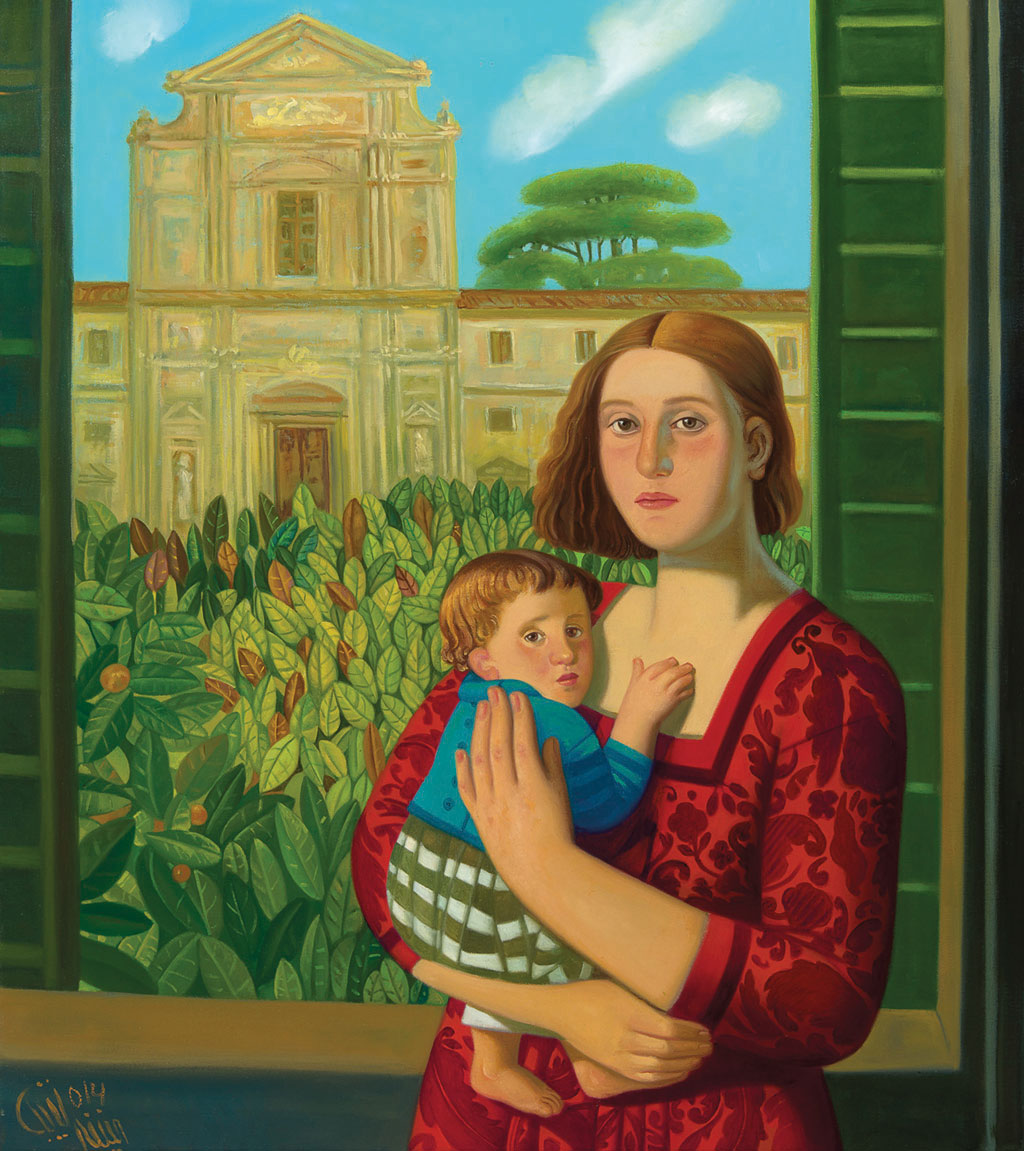
The Window Oil. 2017. Oil on canvas. 80 x 70 cm.
Living in Yemen and working as a professor was an eye opener, as I saw the cruelty of life and the brutality of politics. I realised how much politics is able to turn people's lives into an ongoing struggle, only being about survival and in return from the politics, what people get is always a subsistence. In Yemen, I saw so much sorrow and extreme poverty due to the blockade that had been put in place by some Arab regimes. In order to punish the Yemeni regime, it starved its people.
The people of Yemen are so good and generous, and what was happening was completely unacceptable.
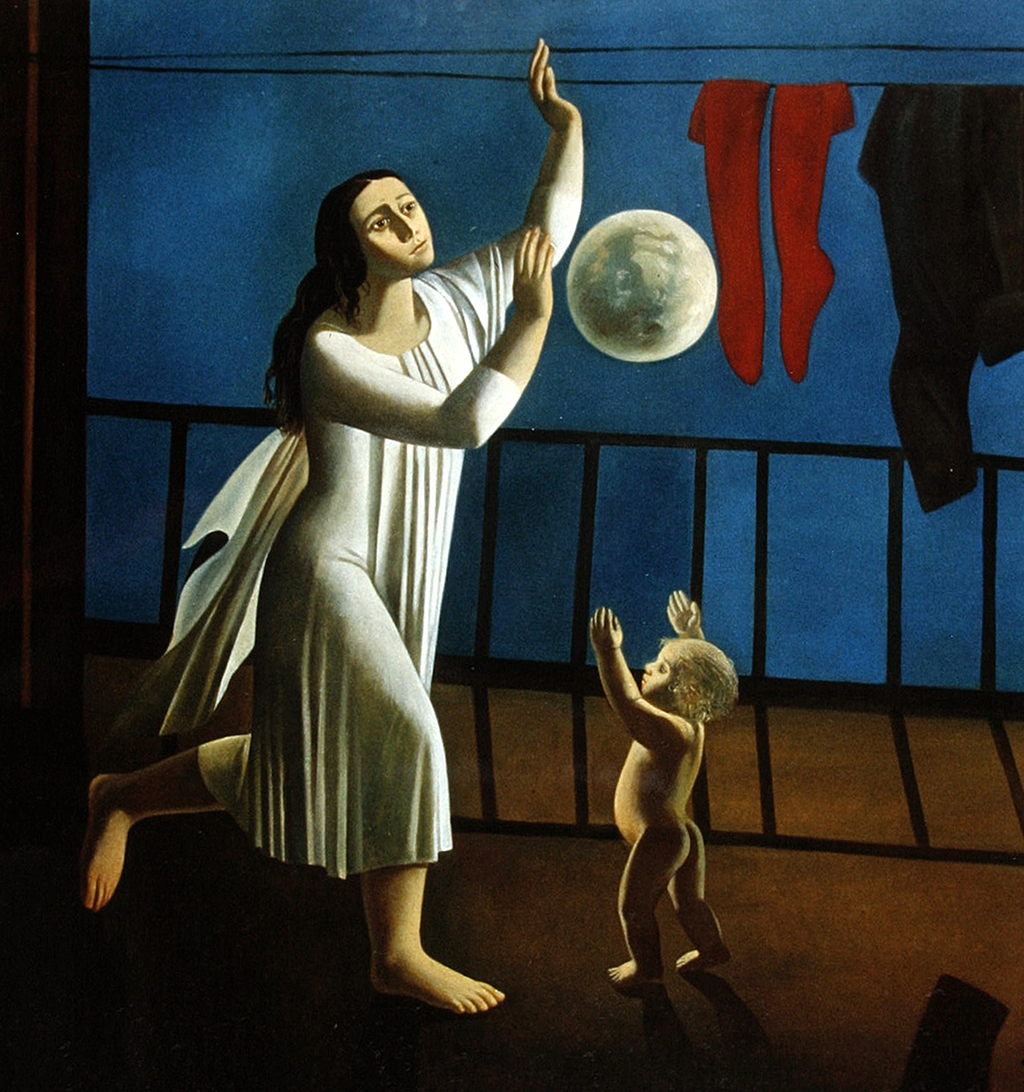
Evening in Aden. 1989. Oil on canvas. 120 x 120 cm.
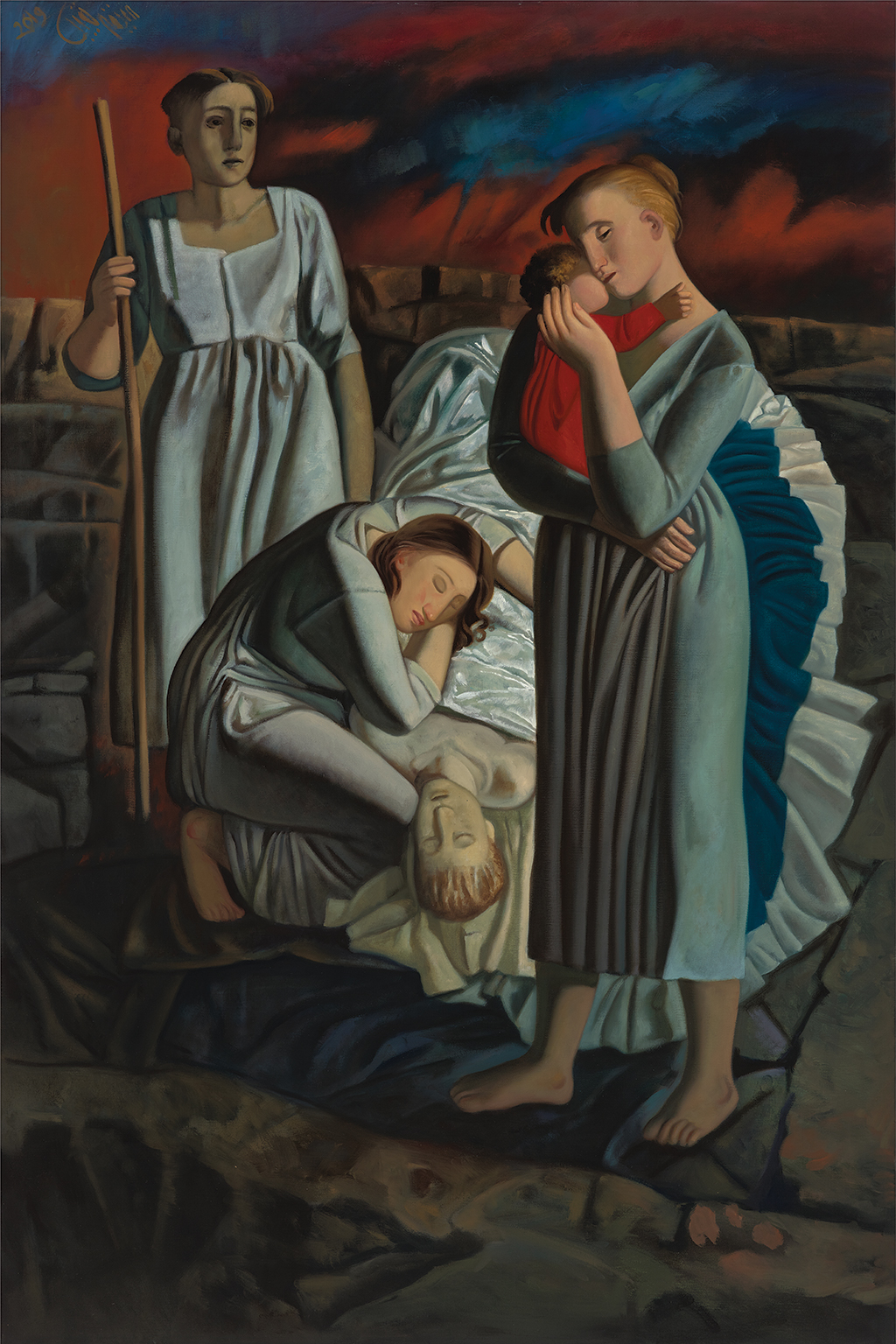
Al Anfal. 2019. Oil on canvas. 150 x 100.
Certainly, art can unite human beings because art in general is human-oriented, away from partisanship and extremism. Art has a deep human mission, which is to open the windows of beauty and its gates to its audience to enjoy and realize the value of fleeting moments in one’s life, the value of happiness, the meaning of love and human bonding.
The beauty and generosity of nature, the peculiarity of everything we see and seek in every moment of our fast life, the moments that follow that, and hope that arises through art, can build bridges, destroy barriers, and help sad hearts grieve.
I believe in art, it is one of the most capable means of transforming the world, reshaping it and changing its compass.
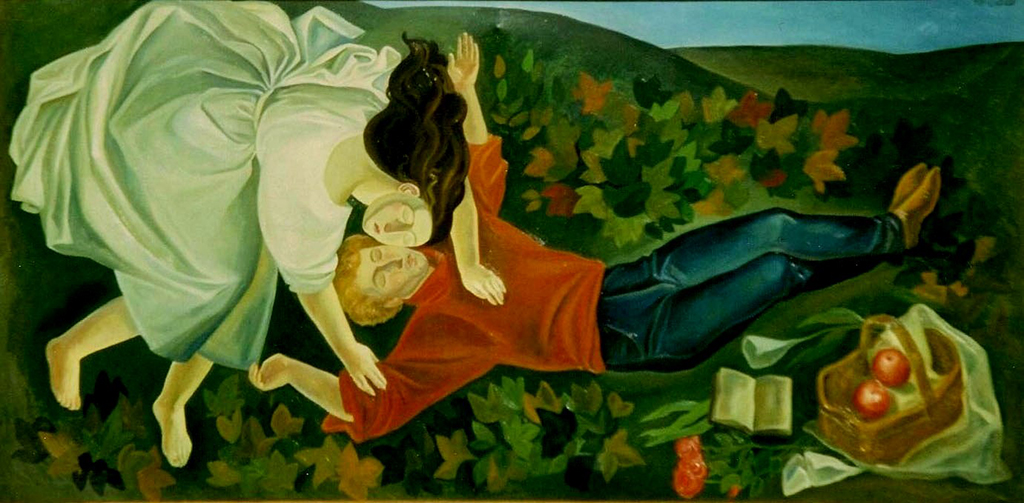
Spring Time. 1982. Oil on canvas. 100 x 180 cm.
In this challenging time of COVID-19, little has changed regarding my timetable or discipline, because I am used to working on my own in my studio, and sometimes I spend a full day without speaking or meeting anyone, as I am busy working on a painting or starting a new job. What has worried me throughout these last three months is my fear for the health of the people I love and my anxiety for them.
I sincerely hope that this difficult period will end for everyone, that these strange times will pass, with all being well and that a remedy is discovered. That may also aid in ending the increased anxiety of fear and isolation. That is a painful repercussion.
I also hope that this course has given an adequate awakening to the many powers that influence the world economy, to start looking at changing economic, social and political policies in order to rearrange relations in the world so that it can protect the environment and protect human and humanity throughout the globe.
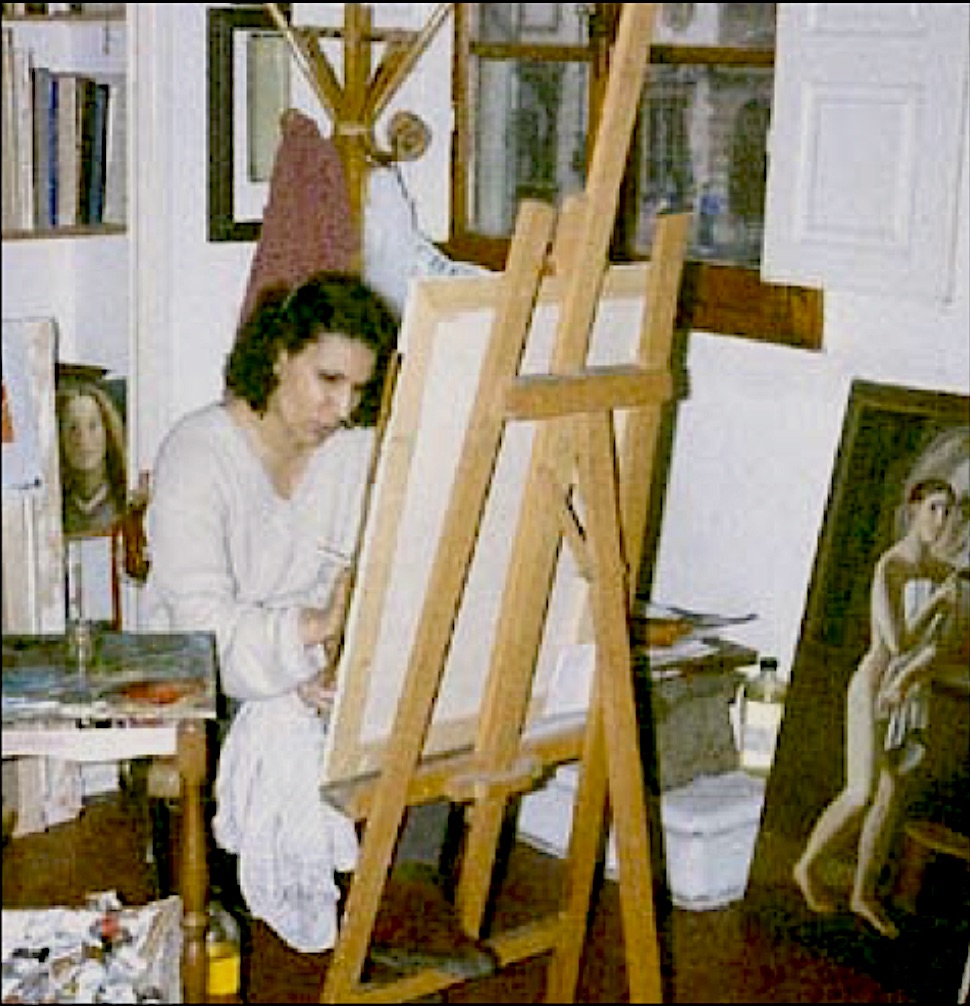
Afifa Aleiby's exhibition " The Echo of Time" will be held at Kristin Hjellegjerde Gallery in London from 2 July to 1 August 2020
Original interview in Arabic:
انا كنت بين اخوتي اخر العنقود كما يقال في الادب العربي ومنذ طفولتي انتبهت الى ان اخوني تقريبا جميعهم كانوا مهتمون بالفن وبكل انواعه. موسيقى وغناء ورسم ونحت وشعر وادب وكان اهتمامهم كذلك ومنذ أعمارهم الصغيرة بالسينما والمسرح وبالقراءة وكان لدينا بالبيت مكتبة عامرة بكل أنواع الكتب والكثير منها من الادب العالمي المترجم كذلك كانت هناك كتب فنية لمجموعة من الفنانين العالميين ضمن مكتبتنا هذه. كنت اراقب واتابع وأحب ما كان اخوتي ينجزونه. وبالضرورة بدأت انا كذلك أقوم بممارسة الرسم ومشاهدة الكثب الفنية وكنت اقرأ كذلك وأحب وبشكل خاص الادب المترجم حيث كان يسحرني ويمنحني الكثير من الخيال والصدق والجمال وكانت كل عطلي الصيفية اقضيها في القراءة والمطالعة.
عندما كنت في الابتدائية وكذلك في المتوسطة كنت أساهم في المسابقات الفنية والتي كانت تقام سنويا في المدارس العراقية حينذاك. بالإضافة الى اهتمام المدرسات بي منذ الصغر لكوني كنت ارسم وأحب درس الرسم. في البيت كذلك كنت اتلقى كل أنواع التشجيع من كل افراد العائلة وبشكل خاص من امي وابي. وعندما أكملت دراستي المتوسطة قررت ان أكون رسامة وكنت احلم بان اذهب الى بغداد لدراسة الفن في معهد الفنون الجميلة مثل اخي فيصل الذي كان حينذاك في بغداد حيث كان قد أكمل دراسته في معهد الفنون الجميلة والتحق بأكاديمية الفنون الجميلة في بغداد. لم أجد معارضة او أي رفض من قبل العائلة لرغبتي هذه بل بالعكس فقد تم ترتيب الأمور بحيث تستطيع الوالدة ان تنتقل معي الى بغداد وترك إدارة شؤون بيتنا بالبصرة تحت اشراف اختي ليلى. وفعلا كان لوجود الوالدة معنا في بغداد قيمة لا تعوض فقد سهل علينا وجودها معنا الكثير من الأمور واهمها عدم الشعور بالغربة او فقدان العائلة.
التحقت في معهد الفنون الجميلة في بغداد ودرست لمدة خمسة سنين فيه وقد كانت هذه السنوات الخمس مليئة بكل ما هو جميل. درست على ايدي الأساتذة العراقيين والذي كان معظمهم من خريجي المعاهد الأوربية وكانوا هم أنفسهم فنانين ومبدعين من الوزن الثقيل مثل الفنان رسول علوان والفنان محمد علي شاكر ومحمد شاكر ال سعيد وميران السعدي وصادق ربيع ورافع الناصري ومحمد مهر الدين ومحمد عارف وماهود احمد وغيرهم كثيرون.
في بغداد وخاصة بداية السبعينات ووجود بعض الاستقرار السياسي والاقتصادي النسبي حينذاك والذي كان له تأثير كبير على حياة الناس والشباب بشكل خاص حيث فتحت الأبواب وبشكل واسع امام الثقافة والفنون وبكل تفرعاتها واخذ اهتمام الناس عموما يزداد عبر المتابعة لأهم الإصدارات وازدهرت الطباعة والتي اهتمت في كل شرائح المجتمع حيث تم اصدار الكتب والمجلات والجرائد ذات الاختصاص بشؤون الطفل والشباب والنساء وظهور الصحافة اليسارية والتي اخذت تنتشر آنذاك وبشكل واسع وعلني في العراق وعبر كل وسائل الاعلام
. كان لهذا الانفتاح الثقافي الكبير دور مهم واكيد على الحياة بشكل عام وعلى تطور انتاجي الفني خاصة في فترة اشتغالي في ذلك الوقت كرسامة لواحدة من اهم الصحف اليسارية والتقدمية العراقية ( جريدة طريق الشعب ومجلة الثقافة الجديدة) حينذاك والتي كانت تقرأ من كل شرائح المجتمع العراقي وبشكل خاص من النخبة ومن المثقفين العراقيين اليساريين. كانت تخطيطاتي في هذه الجريدة لها حضور متميز وملفت للنظر في الوسط الثقافي العراقي لأني كنت اول فتاة شابة ترتاد العمل الصحفي كرسامة.
اثناء دراستي في بغداد ساهمت تقريبا في كل المعارض الفنية والتي كانت تقام بشكل منتظم في أروقة المعهد وكذلك في جمعية الفنانين العراقيين وفي متحف الفن العراقي الحديث (متحف كولبنكيان) في بغداد. وقد اقتنى حينذاك المتحف عملين من اعمالي.
في ذلك الوقت كانت لي متابعات لكل ما ينشر ويصدر عن الحركة التشكيلية العالمية وكنت أحب اعمال الكثير من الفنانين الاوربيين وتسحرني أعمالهم واجوائها وأساليب العمل المختلفة وكنت اتابع ذلك عير القراءة والاطلاع على الكتب الفنية والتي كانت في بيتنا في بغداد وضمن مكتبة اخي فيصل.
كنت أحب الفن الانطباعي ولكني اغرمت بأعمال الفنانين الفرنسيين والمعاصرين للحركة الانطباعية ولكنهم كانوا يتميزون باسلوب خاص بهم، لم يخضع لشروط الانطباعية كظاهرة فنية بدأت تسود حينذاك مثل الفنان تولوز لوتريك والفنان ديكا. أحببت في الوقت نفسه اعمال الفنان الفرنسي الأكاديمي دافيد وكذلك جمالية ورقة اعمال الفنان الفرنسي انجر والرومانتيكي الفرنسي ديلاكروا. كذلك اغرمت بأعمال الفنان الإيطالي بوتشللي والذي عاش في زمن عصر النهضة في فلورنس. عندما استعيد أسباب اعجابي بهؤلاء الفنانين وهم مجموعة متنوعة من الفنانين وعاشوا ازمان مختلفة وفي اوساط كانت تسود فيها مدارس معينة رسمية وغير رسمية لكن الذي كان يسحرني في أعمالهم هو خصوصيتهم وتفردهم. في الوقت نفسه كان لي ميل شديد لمجموعة من الفنانين الروس مثل ريبين أستاذ المدرسة الواقعية واحد اهم فناني مجموعة المتجولين اللذين عاشوا في نهاية القرن التاسع عشر وكذلك الفنان فروبل أستاذ المدرسة الرمزية في روسيا والفنان مايسينكو والفنان فودكين الساحر في فترة الفن السوفيتية. كل واحد منهم كان له أسلوبه الخاص والمتفرد.
في ذلك الوقت كان اثنين من اخوتي غادروا العراق للدراسة في اوربا. اخي الفنان عبدالاله النصير غادر الى روما للدراسة في اكاديمية الفنون الجميلة في روما وأخي فيصل لعيبي كان قد غادر للدراسة في معهد البوز ارت في باريس. لكن انا لم افكر لا في باريس ولا في روما بل قررت الدراسة في موسكو.
قدمت اوراقي للحصول على مقعد دراسي في معاهد موسكو وحصلت على المقعد الدراسي للدراسة في موسكو ومن حسن حظي كان قبولي في واحد من اهم المعاهد الفنية في كل انحاء الاتحاد السوفيتي آنذاك وهو المعهد الوطني للفنون الجميلة (سوريكوف).
كان حلمي وطموحي هو التخصص في الفن الجداري وفعلا حصلت على الموافقة للدراسة في قسم الفنون الجدارية. درست وتخصصت على يد الفنانة الروسية المعروفة والانسانة الرائعة كلاوديا اليكساندرفنا توتيفول.
كان للفن الروسي ودراستي في هذا المعهد تأثير كبير على تطور اعمالي الفنية حيث تعرفت على فن الايقونات الروسية والتي كان من ضمن دراستنا تعلم التقنيات الاكاديمية في كيفية انجاز الايقونة. انه عالم من الفن قائم بحد ذاته، انه سلسلة من التقنيات والحرفية العالية والدراسة العلمية للتأثيرات الزمنية والجو والبيئة والتي يجب ان يتعلمها فنان الايقونات المختص. تعلمت تقنية اعمال الزغريفيتو والافرسكو على الجدار الرطب والجدار الجاف وتعلمت تقنية الفيتراج (تعشيق زجاج الأبواب والنوافذ) وفن الموزاييك. كل هذه التقنيات كل على حدة عالم من السحر المطلق والمفاجئات المذهلة لتلميذة قادمة من بغداد وشبه جاهلة في كل هذه العوالم السحرية. كنت اعمل بحب منقطع النظير ومثل المسحورة في كل هذه العوالم التي كانت بالنسبة تحقيق لأحلام شبه مستحيلة.
كذلك زياراتي الدورية للمتاحف وتعرفي عن قرب على اعمال فطاحل الرسم والنحت العالمي والروسي كل هذا كان يجعلني أحس وكأني اليسا في بلد العجائب.
دراستي في موسكو كانت بالنسبة لي مثل البداية من الصفر. رميت كل ما تعلمته في بغداد خلف ظهري وبدأت من الصفر لأتعلم في دروس التشريج كيفية رسم جسم الانسان، وفي دروس الألوان تعلمت كيفية التعامل مع الألوان وكيفية تحقيق لوحة وكيفية التكوين وتعلمت درس مهم جدا وهو مسؤولية الفنان والقيمة التاريخية للفنون ودورها في تفسير وكتابة التاريخ عبر العواطف والمشاعر. تعرفت على الفن الروسي العظيم والمجهول للكثيرين بسبب الحرب الباردة والتي أغلقت الأبواب ضد كل ما هو روسي. كنت ولا أزال اعتبر نفسي محظوظة بل صاحبة حظ عظيم. لأني استطعت دخول أبواب كانت مغلقة على اقراني من الشباب العراقي او العربي او حتى الأوربي. مررت بكل هذا ليس بشكل سطحي بل بحب واحترام وتقدير عظيم. تجربتي ودراستي في موسكو علمتني ان اتعرف على كل الفنون في العالم وان اتعلم التمييز بين ما هو فن انساني وحقيقي وبين ما هو مجرد صنعة وعرض عضلات.
زرت المتاحف والمسارح والمكاتب واستمعت للموسيقى الجميلة وقرأت الادب الروسي بلغته الام احببت بل عشقت تشيخوف ,كوركي, تورجينيف وديستويفسكي. رأيت أجمل الأفلام الروسية. أحببت شارع اربات وحدائق كوركي بارك وتلال غابات لينين والجمال الفريد لغابات اسماعيلوفسكي بارك. أحببت موسكو واحببت أهلها وكنائسها وقراها، انهارها وريفها.
السياسة
كل سنوات طفولتي وسنوات شبابي ونضجي والعراق يعيش الاحزان والالام المتواصلة والتي انعكست بالضرورة على حياتنا كعراقيين. للسياسة في العراق دور رهيب ومؤثر على تفاصيل حياتنا جميعا سواء كنا في داخل الوطن او خارجه. كنا نعرف ما الذي يحدث ويدور خلف الكواليس. كانت الأجواء دائما ملغومة. كنا في حذر دائم وخوف وترصد دائم. نشم المخاطر ونتوقعها في أي لحظة. كعراقيين كان الحبل السري يربطنا بالوطن كما كان يربطنا بالأم. فلم يحمينا الابتعاد عنه من مخاوفنا عليه وهذا بالضرورة له انعكاساته على كل ما كنا نقوم به او ننجزه في حياتنا اليومية كعراقيين خارج حدود الوطن.
اثناء وجودي خارج العراق انتجت مجموعة من الاعمال الفنية والتي كانت ذات نفس سياسي مباشر وكردود أفعال لمعاناتنا كعراقيين وكموقف لي ضد كل ما يحدث في العراق وما يجري لأهله على ايدي نظام دكتاتوري لم يكن له شبيه في المنطقة. وعن ماهية الماكنة الإرهابية التي كانت تسحق حياة الناس وتدمر كل أواصر التواصل والود والمحبة. غيرت البشر وحولت العراق الى ارض للرعب والقسوة.
استخدامي للعنصر النسوي كوسيط لتوصيل أفكاري ومشاعري اجده فعالا وذات قدرة عالية لخلق العوالم التي اريد التعبير عنها. انا شخصيا اعتبر المرأة هي الأصل وهي القامة والعمود الذي تقف عليه ركائز الحياة وهي العنصر الأكثر إيجابية وهي التي كانت وراء كل حركات التغيير وهي التي كانت الضحية رقم واحد لكل أنواع التغيير الذي حدث على مر العصور ومنذ بدء الخليقة والى يومنا هذا. انها عنصر محرك وضحية بالوقت نفسه. هي الحاضنة وهي المربية وهي العنصر الاجمل. معظم لوحاتي تحمل فكرة معينة لكن الفكرة لا يعني انها بالضرورة سياسية او ذات ابعاد اجتماعية او تعليمية. هناك أفكار ذات ابعاد فنية بحثه.
أحيانا اللون هو الفكرة التي اريد التعبير عن قيمته او التكوين هو القضية التي تشغلني في هذا العمل او ذاك، او الضوء هو فكرتي الأساسية في اللوحة، او الجمال ومعانيه واوجهه المتعددة هو فكرتي التي اريد توصيلها للناس. والمرأة عنصر مهم بالنسبة لي لأنها تملك كل الإمكانيات والتي تعينني على قول ما اود قوله عبرها. لأنها حاوية كل هذه الجوانب المتعددة والتي انا بحاجة لها. هي فكرتي ووسيلتي واداتي وهي الكائن الذي يجسد الجمال بكل جوانبه وهي اجمل المخلوقات على وجه الارض.
في موسكو درست عصر النهضة الإيطالية وتعرفت على جوانبه الإنسانية وعلى الجمالية المتفردة في اعمال الفنانين واللذين كانوا اول واضعي لحجر اساس النهضة الفنية والتي ازدهرت وتطورت لتخلق عصر من النهضة المتكاملة الجوانب. تعرفت بعمق على جيوتو والكيرلاندايو وبيير ديللا فرانجسكا و مازاجو وباولو اوجيللو ودوناتيللو وتشلليني. هؤلاء هم من اسسوا لعصر النهضة في الفنون بكل فروعه والهندسة والمعمار. ثم كانت الثمار فيما بعد وظهروا فطاحل كان لهم حضور وتأثير في العلوم والمعارف المتعددة والمذهلة في كل الاتجاهات.
بعد انتهاء دراستي في موسكو ذهبت للعيش في روما بعد زواجي من الفنان العراقي جبر علوان. كانت هذه الفترة مرحلة اغناء لي وعملت على تطوير منحى وتوجه افكاري وتعميق علاقتي بالناس وفي كل ما كان يحوطني. زياراتي للمتاحف كذلك وتجوالي الدائم في مدينة أقرب الى متحف من ان تكون مدينة او سوق. اهل روما وناسها. جمال الطبيعة فيها. في روما كذلك ولد ابني الفنان اذار جابر. لكني لم أستطع البقاء فيها لفترة طويلة بسبب صعوبة العثور على عمل فيها وصعوبة الحياة فيها بالنسبة لي آنذاك اضطرتني الى تركها والسفر الى اليمن لأني حصلت حينذاك على فرصة عمل لي للتدريس في معهد الفنون الجميلة في مدينة عدن كنت احوج اليها آنذاك من أي شيء اخر. عشت في اليمن في مدينة عدن ومارست عملي كأستاذة في معهد الفنون الجميلة وكانت هذه فرصة لي لأرى قساوة الحياة ووحشية السياسة. أدركت كم السياسة قادرة على تحويل حياة الناس الى صراع مستمر فقط من أجل البقاء وبالمقابل ما يحصلون عليه هو دائما الكفاف. في اليمن كنت أرى احزان كثيرة وفقر شديد بسبب الحصار الذي كان قد مورس من قبل بعض الأنظمة العربية لعقاب نظام عبر تجويع اهله ولكن شعب اليمن كما هي كل الشعوب في العالم كان شعبا طيبا وكريما.
اكيد الفن يمكنه ان يوحد البشر لان الفن عموما ذات توجهات إنسانية بعيدا عن التحزب والتطرف. للفن رسالة إنسانية عميقة وهي فتح منافذ الجمال وابوابه لكي يستمتع بها الانسان ولكي يدرك قيمة اللحظات الهاربة وقيمة السعادة ومعنى الحب والترابط الإنساني. جمال الطبيعة وكرمها وخصوصية كل ما نراه ونلتمسه في كل لحظة من حياتنا الهاربة لحظات تتلاحق وامل يولد. عبر الفن يمكننا ان نبني الجسور ونهدم الحواجز ونسعد القلوب الحزينة. الفن وانا مؤمنة بذلك من أكثر الوسائل القادرة على تغيير العالم وإعادة تشكيله وتغيير بوصلة اتجاهه.
في زمن الكورونا لم يتغير الشيء الكثير في مسيرة اوقاتي او نظام حياتي. لأني متعودة على العمل لوحدي في مرسمي وأحيانا اقضي نهارا كاملا دون ان أكلم او التقي باي كان حيث أكون فيه منشغلة بإنجاز لوحة ما او البدء في تنفيذ عمل جديد.
الشيء الذي يقلقني في هذه الشهور الثلاث هو خوفي على صحة الناس الذين أحب وقلقي وخوفي عليهم.
اتمنى ان تنتهي هذه الفترة الصعبة بالنسبة للكثير من الناس وأتمنى ان تمر على خير وان يتم اكتشاف العلاج الذي يضع حد للقلق الذي أصبح ممارسة يومية حيث نرى زيادة الخوف والعزلة وهذا شيء اكيد مؤلم. كما ارجوا ان تكون هذه المرحلة قد أعطت درسا كافيا للكثير من القوى المتنفذة على اقتصاد العالم بتغيير سياساتها الاقتصادية والاجتماعية والسياسية من اجل إعادة ترتيب العلاقات في كل العالم من اجل حماية البيئة وحماية الانسان والإنسانية في كل الكرة الأرضية.
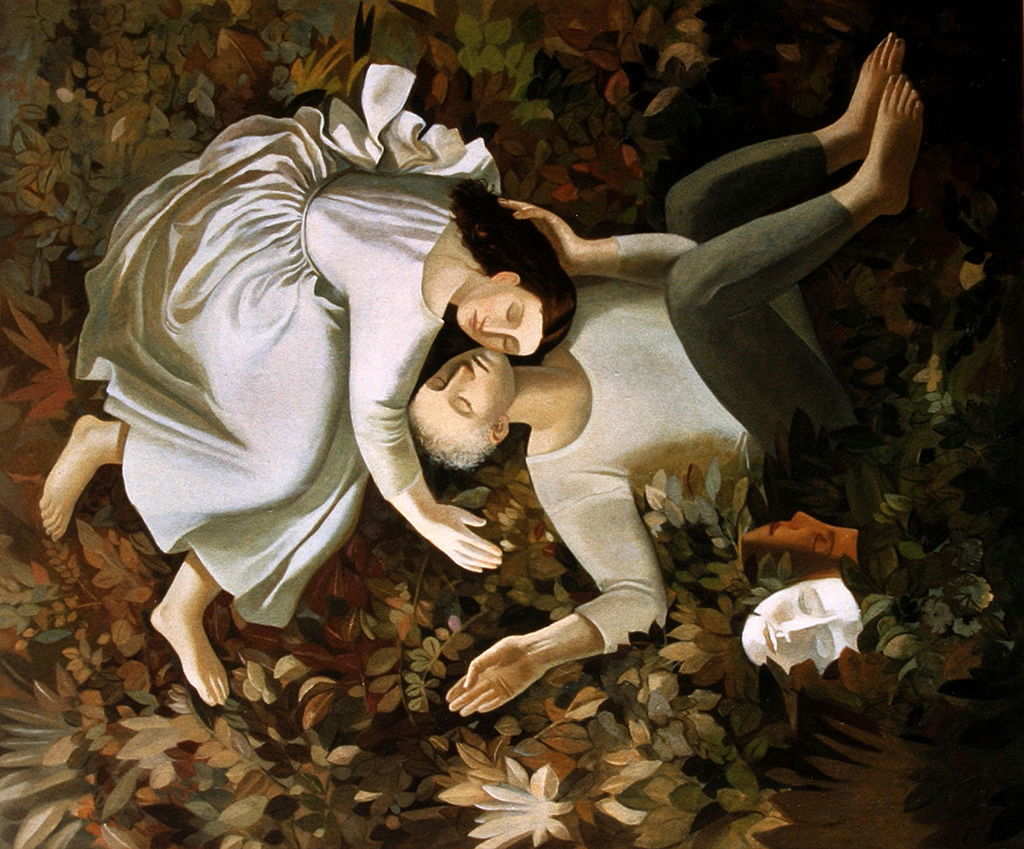
Masks. 1985. Oil on canvas. 100 x 120 cm.
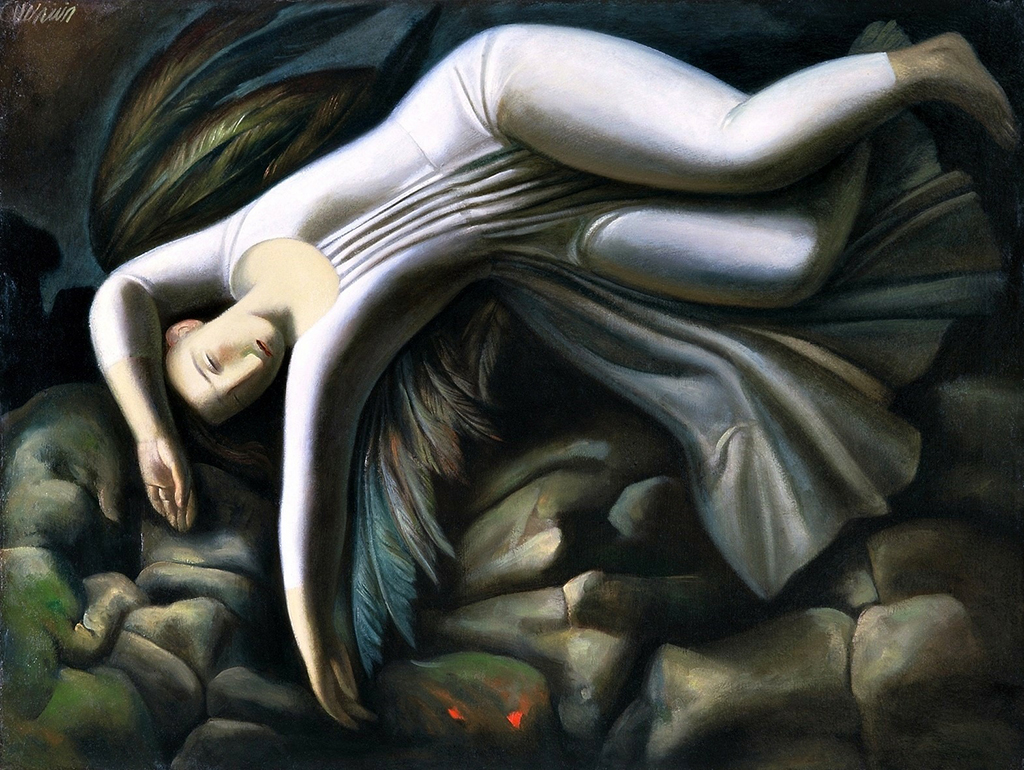
Fallen Angel. 1996. Oil on canvas. 60 x 80 cm.
Afifa Aleiby is an Iraqi artist, born in the city of Basra, in the utmost southern part of Iraq in 1953. She took up her studies at the Institute of Fine Arts in Baghdad while worlinh as an illustrator for the Iraqi press, before leaving Iraq for the Soviet Union in 1974 to study and specialize in monumental art at the renowned Suikuv Institute in Moscow. Due to the political situation in Iraq, she was unable to return to her native country after the completion of her studies, and decided to move to Italy and later back to Moscow, before settling in Yemen to work as a teacher at the Institute of Fine Arts in Aden, where she also illustrated children’s books and magazines. Aleiby has since been living and working in the Netherlands, and keeps contributing to a great deal of cultural activities in support or the Iraqi and international democratic movement, in the struggle against terrorism, racism, war and dictatorship. Not having returned to her native country for 35 years, she has built a strong connection to every country she has been living in since leaving Iraq, both in a cultural and personal sense. Her connection to humanity and different cultures has made solidarity transcending geographical and cultural borders an important theme in her work. Bringing together different influences from Renaissance painting to religious icons and social realism, she uses the female figure as a recurring motif to reflect beauty, taste, politics and society. She has participated in numerous exhibitions through out her career, from Baghdad and Moscow to Yemen, Italy, Syria, Lebanon, England and the United States, as a representative of the artistic and cultural face of the Iraqi civilization. Selected exhibitions include Theater of Operations: The Gulf Wars 1991–2011 at MOMA PS1, NY (2019-2020), A Retrospective of her works in the Museum Catharinagasthuis in Gouda (The Netherlands), Re-Existence, Pulchri Studio, Den Haag, The Netherlands (2018); Boushahri Gallery, Kuwait City, Kuwait (2017); Boushahri Gallery, Kuwait City, Kuwait (2014); De Twee Pauwen, The Hague, The Netherlands (2014); Boushahri Gallery, Kuwait City, Kuwait (2010); Gallery Prima Vista, Maastricht, The Netherlands (2008); Galleria Tornabuoni, Florence, Italy (2008); Zink Exposities, Bergen, The Netherlands (2008); Transit Art, Amersfoort, The Netherlands (2008); Ministry of Foreign Affairs, The Hague The Netherlands (2007); De Twee Pauwen, The Hague, The Netherlands (2007); Daar Al Mada, Damascus, Syria (2000); Beirut Biennale, Beirut, Lebanon (2000); Arabic Cultural Centre, Brussels, Belgium (1999); Tjalf Gallery, Amsterdam, The Netherlands (1999); Het Catharina Gasthuis Museum, Gouda, The Netherland (1999); Fortezza S. Francesco. Omaggio a Dilvio Lotti, San Miniato, Italy (1997); Het Veen, Amsterdam, The Netherlands (1997); Sale Topical, omaggio Gino Severini, Montespertoli, Italy (1995); Zalm Hotel, Gouda, The Netherlands (1995); City Gallery, Gouda, The Netherlands (1995); Centro culturale Studio Palazzo, Festival dei due mondi, Spoleto, Italy (1993); and Sala dell’ Esposizioni Quartiere No 1, Florence, Italy (1992).

